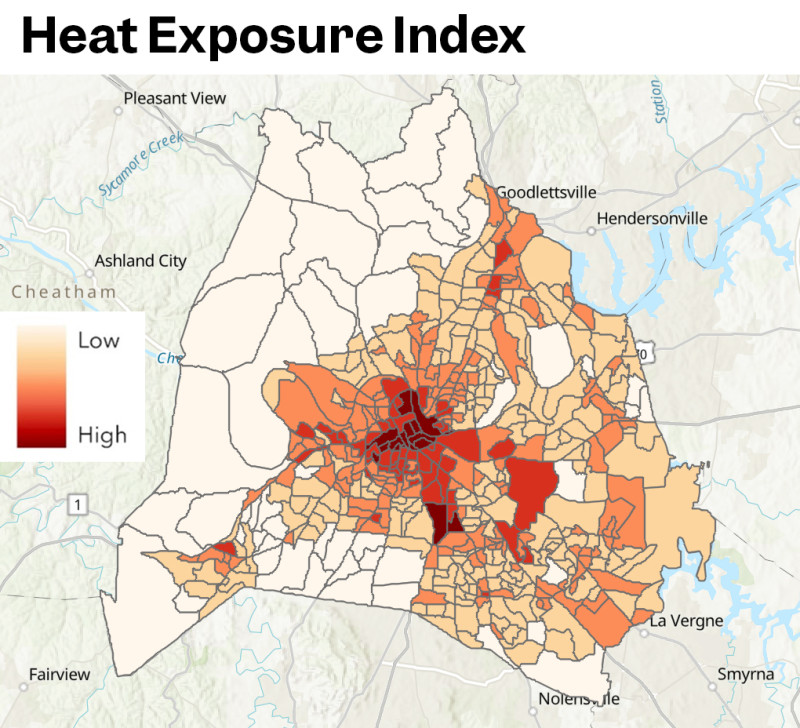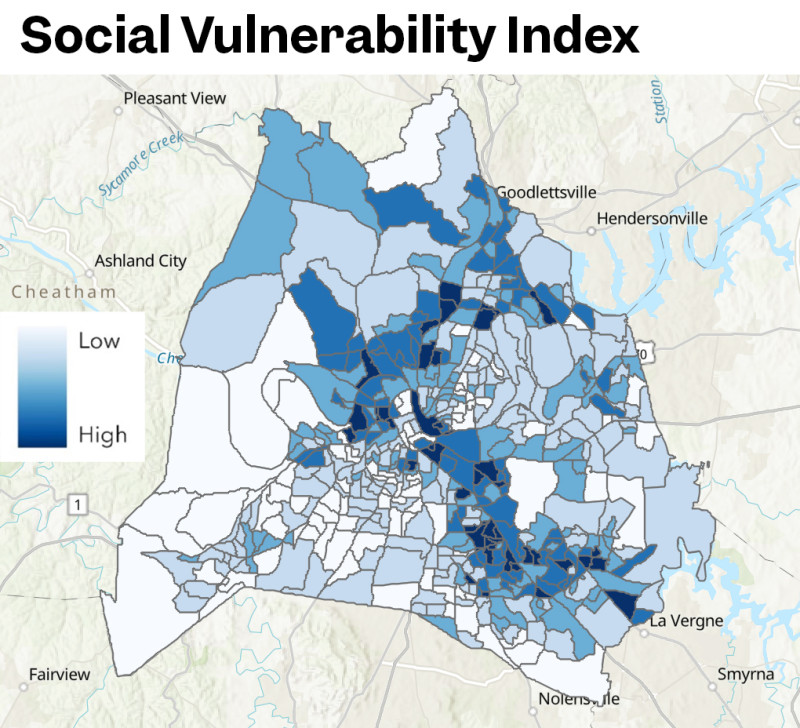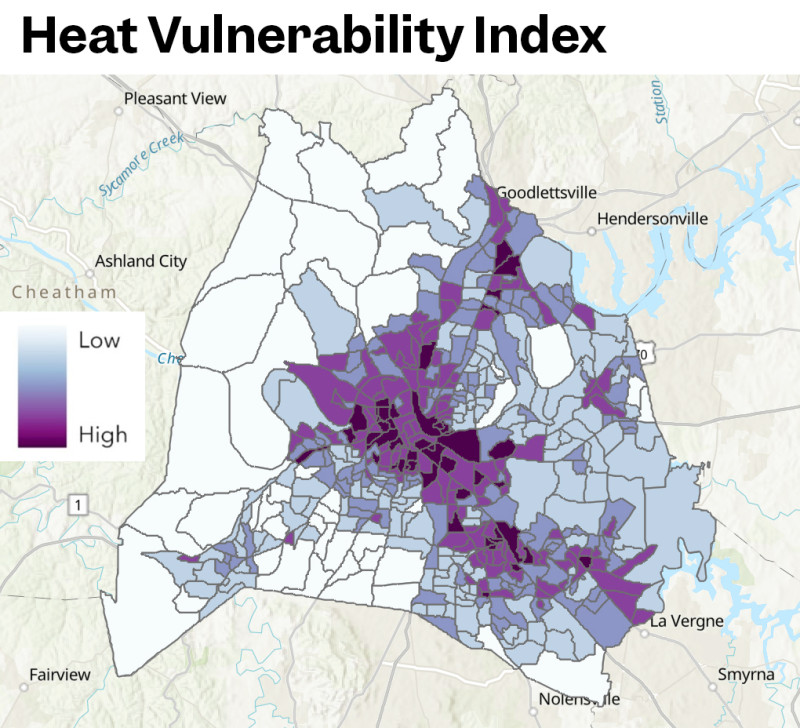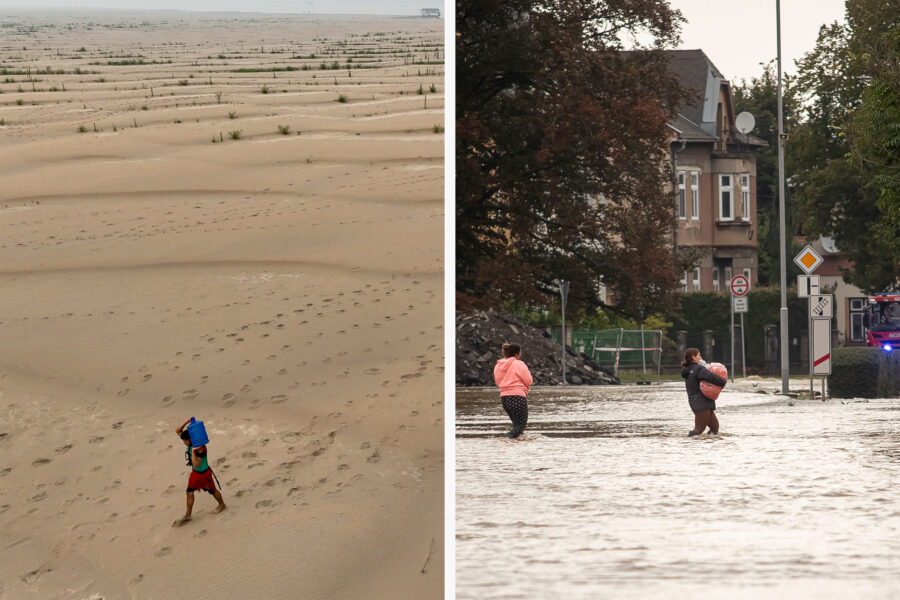Slow Wheels of Policy Leave Low-Income Residents of Nashville Feeling Brunt of Warming Climate
NASHVILLE, Tenn.—Michael Henry spent four years unhoused before securing an apartment at Andrew Jackson Courts, one of Nashville’s oldest public housing complexes. When he and his dog, Vincent, moved into the unit a year ago, he looked at the thermostat in hopes of turning on the air conditioning.
Little did he know. “There’s no air conditioning, just heat,” Henry, 58, remembers the maintenance worker telling him.
Nearly 70 percent of U.S. households have central air conditioning, while 10 percent have no AC at all, according to the Brookings Institute. Tennessee is one of many states that doesn’t define air conditioning as an essential utility, leaving renters responsible for purchasing window units to keep their homes cool if a landlord doesn’t provide them.
The state also has one of the highest percentages of energy-burdened residents in the nation, which causes some to refrain from using air conditioning, according to the American Council for an Energy-Efficient Economy.
Explore the latest news about what’s at stake for the climate during this election season.
Heat stress is the leading cause of weather-related deaths, and medical guidelines list air conditioning as the top treatment for heat-related illnesses. However, national and local experts say there’s a lack of action to create policies that keep up with a warming climate, and a misperception around the risk of heat is one of the reasons why few local governments have enacted cooling legislation.
Some experts want the U.S. Department of Housing and Urban Development (HUD) to require housing authorities and landlords receiving housing vouchers to provide tenants with air conditioning. HUD currently requires housing authorities to adequately heat properties but does not have a standard for maximum allowable temperatures.
“We have seen air conditioning as a luxury, in fact, for decades. And we have not yet, I think, as a society accepted that air conditioning is a life-saving necessity,” said Ashley Ward, director of the Heat Policy Innovation Hub at Duke University.
Rise of Air Conditioning
When the Nashville Public Housing Authority, now Metropolitan Development and Housing Agency, took over Andrew Jackson Courts from the U.S. Housing Authority in 1939, less than a quarter of 1 percent of homes nationwide had air conditioning, and only 22 million were wired for electricity.
In 1947, six years after residents filled Cayce Place, another public housing development in Nashville without air conditioning, low-cost air conditioning units became widely available.
Tennessee adopted the Uniform Residential Landlord and Tenant Act in 1975. The Uniform Law Commission, a nonprofit unincorporated association comprised of state commissions on uniform laws from each state, developed the act in 1972 to clarify and standardize landlord-tenant law across the country, according to the Policy Surveillance Program housed at Temple University in Philadelphia. Twenty-one states have enacted the act, but only one state—Oregon—requires landlords to install a cooling system in new buildings.
Tennessee’s law defines “essential services” as gas, heat, electricity and any other obligations imposed upon the landlord that materially affect the tenant’s health and safety.
Nearly 51 percent of homes in the U.S. had air conditioning in 1975, The Washington Post reported.
The state authorized its health department to establish minimum health standards in rentals two years prior, in 1973. The department required every dwelling unit to have heating and maintain a temperature of at least 68 degrees.
It wasn’t until then-President Jimmy Carter authorized funding to help the state recover from a drought and heat wave in 1980 that local leaders began to address a “unique need.”
The state used the funding to transport heat victims and provide emergency shelters, air conditioners and fans. Nearly 10,000 Americans died across the country, including more than 75 elderly Tennesseans, the Tennessean reported.
The Tennessee Community Service Administration awarded the health department funding to buy electric fans and pay electricity bills for low-income residents with health illnesses brought on or intensified by extreme heat after the 1980 heat wave, the Tennessean reported. Nashvillians experienced temperatures that hovered at 100 degrees for five days in July of that year.
Under-Calculated Vulnerability
When Marvin Cox started working at the Metropolitan Action Commission of Nashville and Davidson County in 2004, the social service agency had long provided air conditioning units to low-income residents. Cox, the director of family and community services, has watched the air conditioning units fly off the shelves during the summer months.
However, not everyone qualifies for the program, leaving residents who aren’t 60 years old or older, disabled or have children 5 years old or younger scrambling to find cooling resources.
A spokesperson for the agency said it adopted the criteria from the federal government, but some experts say there is a misperception around who is vulnerable to heat.
In neighboring North Carolina, the health department reported that mostly males ages 25 to 44 visited emergency departments for heat-related illnesses in 2023.
“My guess is that the vulnerability to heat is much greater than what that program would address,” Ward said, adding that the North Carolina Department of Health and Human Services’ report dispels myths around who’s vulnerable to heat.
Disparities Among Black Households
The agency’s data shows that during the last five years, the majority of residents who requested fans and air conditioning units from the Metropolitan Action Commission of Nashville and Davidson County were Black.
Black households are less likely to have air conditioning, and in metro areas where there’s a substantial number of homes without air conditioning, significant Black-white disparities in access exist, according to the Brookings Institute.
The majority of residents who live in public housing in Davidson County, where Nashville is located, are also Black, according to the Metropolitan Development and Housing Agency’s five-year consolidated plan for housing and community development.
Andrew Jackson Courts and Cayce Place are located in neighborhoods where residents are more exposed and most vulnerable to heat illness than other parts of the county, according to the Metropolitan Government of Nashville and Davidson County’s “Understanding Nashville Heat” story map, which provides data on extreme heat.



Cayce Place residents also live in an area where heat has exacerbated chronic health conditions, according to the data. Researchers also found that Cayce Place has one of the highest asthma rates in the county due to poor air quality.
“I mean, it’s insane, to me, that MDHA (Metropolitan Development and Housing Agency) doesn’t have air conditioning in all their units,” said Carol Ziegler, a professor of nursing at Vanderbilt University. “It’s not mandated, and it really needs to be.”
The Metropolitan Development and Housing Agency did not respond to repeated requests to comment.
Tenants Scramble to Keep Cool
Nearly 6,100 Nashville households lacked air conditioning in 2013, according to the U.S. Census Bureau. The U.S. Energy Information Administration, which asks only if a household uses AC, reported that approximately 380,000 homes in Tennessee did not use central air conditioning in 2020.
It took Annastacia King three months to purchase a window unit for her apartment at Cayce Place. Without air conditioning, the unit felt like it was more than 100 degrees inside, she said.“It’s like stepping in hell.”
The 32-year-old often hoped for a breeze to arrive to cool herself and her now 5-year-old son.
If a person was exposed to extreme heat all day, they could cool down at night and have a much better chance of not experiencing heat-related illnesses or exacerbating chronic diseases in the past. But now, nighttime temperatures are about 10 degrees warmer than they used to be, Ziegler said.
“It’s those nighttime temperatures that really make it hard for people to cope physically,” she added.
Researchers have found that even fans are proving to be ineffective.
“After a certain temperature, the only thing a fan does is blow around hot air. It doesn’t actually do anything to cool anything off,” Ward, one of the researchers who studied the use of fans, said.
“It is a moral failing in this country that we have people making the choice between running an air conditioner and buying food or medicine…”
Daysia Vixon, 25, and Joseph Jones, 28, lived in Cayce Place without air conditioning for two years with two young children before purchasing window units from a pawn shop. Jones said they often stayed in their car to keep cool as their apartment reached 80 to 95 degrees inside.
“It is a moral failing in this country that we have people making the choice between running an air conditioner and buying food or medicine or having to go sit in their car to cool off at night because they have no air conditioning in their home,” Ward said.
While living at the property for four years, Lexus Ikeard’s two children experienced seizures due to the heat in 2021 and 2022, she said.
The 27-year-old took them to the hospital and was told she could receive an air conditioning unit for free from the Metropolitan Action Commission of Nashville and Davidson County. Ikeard said she never received a unit from the agency, but in June, she moved out of Cayce Place and into an apartment with air conditioning.
Heat Exacerbates Health Conditions
When Ziegler worked in a clinic full-time, she mostly saw people coming in for emergency room follow-ups for heat-related illnesses during the summer months.
The Tennessee Department of Health reported 3,009 heat-related hospitalizations and emergency department visits in Davidson County from 2010 to 2021. The department reported 300 emergency department patient encounters regarding heat-related illness and three deaths in 2023.
But some experts say it can be hard to quantify heat-related illnesses.
“We really don’t have good data on heat-related illnesses,” Ziegler said, adding that sometimes hospital visits are not coded as attributed to the heat.
Still, the average temperatures in the state have risen in almost every decade for the past 50 years, with 2022 being Nashville’s sixth hottest summer on record. Residents have experienced humid heat waves, with the heat index reaching over 105 degrees.
If you have humidity and you don’t have air conditioning, that can really lead people into a health crisis, Ziegler said. She added that people are unaware of how heat can put pressure on the heart and lungs—especially for people with diabetes, hypertension or asthma.
Air conditioning is the most prominent technology used to reduce the risks of heat stress, according to a 2012 study published in the Journal of Political Economy.
“I think there’s this sort of lack of awareness about even if you’re not in the sun, but it’s still hot in your home, how dangerous that can be for you over time,” Ziegler said.
Mandates for Air Conditioning
There’s been momentum toward addressing the dangers of heat over the years, but policy moves slowly.
“Our policies that are in place are not adequate to meet this moment, and we do need some significant policy reconsideration,” Ward said.
HUD requires public housing authorities to maintain a minimum temperature of at least 68 degrees, but it does not have a maximum temperature standard.
HUD defines extreme heat as a period of high heat and humidity with temperatures above 90 degrees for a minimum of two to three days.
Some people still view air conditioning as an individual threat rather than a public health threat, as other utilities such as plumbing, water and heat are treated, said Jonathan Wilson, deputy director of the National Coalition of Healthy Housing.
Ward and Ziegler think that should change, and HUD should require public housing authorities and landlords receiving housing vouchers to provide tenants with adequate cooling.
“Ideally, if you had federal regulation in place, the states would have to follow. In the absence of such, the states are left to their own devices,” Ward said.
At the state level, property owner associations have opposed cooling legislation, citing concerns about the expense of providing air conditioning to tenants.
In California, air conditioning is not required to ensure a rental is habitable. One bill introduced in the state’s Senate sought to change that but failed in 2022.
“Historically, there’s always been tension between business interests and the interests of tenants.”
The California Apartment Association opposed the bill, saying that it ignored the variety of climates in the state, failed to consider the complexities of adding efficient cooling systems to older buildings and would have further burdened the power grid.
A year later, in 2023, the Los Angeles City Council unanimously passed a motion to study the costs and feasibility of mandating air conditioning in all rentals. In January, Los Angeles County’s Board of Supervisors voted to direct staff to draft an ordinance to set a maximum temperature for rentals.
“Historically, there’s always been tension between business interests and the interests of tenants,” Wilson said, adding that property owners have received a sympathetic ear due to skyrocketing housing costs.
Wilson said the National Association of Home Builders influences the International Code Council, which develops codes that ensure property safety.
One example is when the Council required residential fire sprinklers in all new one- and two-family dwellings and townhouses in 2009. The mandate was defeated in 23 states, and only two approved it without any amendment, according to the National Association of Home Builders.
Few Local Cooling Regulations
The National Center for Healthy Housing assisted Dallas leaders with changes in the city’s code of ordinances that set high temperature thresholds. In 2016, the city established an ordinance that requires all rental units to have air conditioning that can bring the temperature to 85 degrees or lower.
It’s one of a few local governments that have enacted rental cooling regulations over the years.
In 2020, Montgomery County, Maryland, required property owners to supply renters with air conditioning services that kept temperatures at 80 degrees or less between June and October.
In 2022, Oregon required landlords to provide air conditioning in new buildings. It is also the first state to experiment with using Medicaid money to prevent the health effects of extreme heat by providing vulnerable residents with air conditioners.
Arizona is one state that views air conditioning as an essential need but doesn’t mandate building owners to provide it. In the absence of such a law, Phoenix and other municipalities have enacted cooling ordinances requiring that all habitable rooms of rental units be held to a temperature of no greater than 82 degrees.
Tennessee preempts local governments from enacting legislation that is in addition to its landlord-tenant law, which might prohibit the Metropolitan Government of Nashville and Davidson County from establishing its own cooling legislation.
“By not listing air conditioning, there is a strong argument that the state intentionally left air conditioning out of the law, and local governments cannot require landlords to offer air conditioning to tenants,” Wallace Dietz, director of law for the Metropolitan Government of Nashville and Davidson County, wrote in an email, adding that he could be wrong.
In the South, Air Conditioning’s Cost
One worry some have about mandating air conditioning in rentals is the tenant’s energy costs.
The East South Central Census region—which includes Alabama, Kentucky, Mississippi, and Tennessee—has the highest percentage of households with high energy burdens compared to other regions, according to the American Council for an Energy-Efficient Economy.
The council found that 38 percent of households in the region paid more than 6 percent of their income on energy bills.
A person may have air conditioning, but if they can’t afford to pay their energy bill to run it, that’s akin to them not having one, Ward said.
The Metropolitan Action Commission of Nashville and Davidson County offers a low-income home energy assistance program to offset the cost of cooling bills.
The majority of residents who received assistance during the summer months over the last three years were Black, according to the agency’s data.
Black households spend 43 percent more of their income on energy costs compared to white households, according to the American Council for an Energy-Efficient Economy’s study.
Tenants said the Metropolitan Development and Housing Agency pays for the energy bills of Andrew Jackson Courts and Cayce Place residents.
But Henry, who lives at Andrew Jackson Courts, thought the lack of air conditioning was a “deal breaker.”
Open Table Nashville, a nonprofit that provides street outreach and housing navigation to Davidson County residents, bought him a window unit from Walmart when he moved into the apartment.
Jonmaesha Beltran is a freelance journalist based in Nashville, Tennessee. After obtaining a master’s degree in investigative journalism from Arizona State University, she reported on housing during a year-long fellowship at Wisconsin Watch, an investigative news outlet.
About This Story
Perhaps you noticed: This story, like all the news we publish, is free to read. That’s because Inside Climate News is a 501c3 nonprofit organization. We do not charge a subscription fee, lock our news behind a paywall, or clutter our website with ads. We make our news on climate and the environment freely available to you and anyone who wants it.
That’s not all. We also share our news for free with scores of other media organizations around the country. Many of them can’t afford to do environmental journalism of their own. We’ve built bureaus from coast to coast to report local stories, collaborate with local newsrooms and co-publish articles so that this vital work is shared as widely as possible.
Two of us launched ICN in 2007. Six years later we earned a Pulitzer Prize for National Reporting, and now we run the oldest and largest dedicated climate newsroom in the nation. We tell the story in all its complexity. We hold polluters accountable. We expose environmental injustice. We debunk misinformation. We scrutinize solutions and inspire action.
Donations from readers like you fund every aspect of what we do. If you don’t already, will you support our ongoing work, our reporting on the biggest crisis facing our planet, and help us reach even more readers in more places?
Please take a moment to make a tax-deductible donation. Every one of them makes a difference.
Thank you,
David Sassoon
Founder and Publisher
Vernon Loeb
Executive Editor
Share this article
Disclaimer: The copyright of this article belongs to the original author. Reposting this article is solely for the purpose of information dissemination and does not constitute any investment advice. If there is any infringement, please contact us immediately. We will make corrections or deletions as necessary. Thank you.








